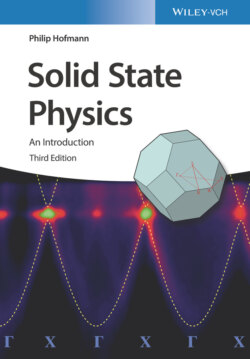Читать книгу Solid State Physics - Philip Hofmann - Страница 11
Preface to the Third Edition
ОглавлениеThe third edition of this book introduces numerous improvements throughout the text, in particular in the description of covalent bonding in Chapter 2 and in the discussion of the Bloch theorem and the nearly‐free electron model in Chapter 6.
The most significant changes are related to the problem sections in each chapter. In addition to the “traditional” type of problems that require an analytical solution, I have now included a number of problems that need to be solved numerically. Their complexity varies from plotting a simple function to calculating the carrier densities in a semiconductor. By introducing this new type of problems I hope to strengthen the students' computational skills, to overcome the restriction of being able to calculate solely what can be approximated using a simple model, and to impart upon students the capability to “play” with model parameters in order to explore what might happen in different physical situations. Moreover, exercises such as 4.4 and 6.10 are intended to help students understand the way phonon dispersions or electronic states are plotted as one‐dimensional cuts through a multi‐dimensional Brillouin zone. For instructors, Python scripts for individual problems are provided as part of the instructor resources that are available from the publisher.
Another major change in the problem sections is the addition of a “basic concepts” section in addition to the “discussion questions” and the more complex “problems” from the second edition. Many (but not all) of the new “basic concepts” questions are of the multiple‐choice type and the solutions to all of them are given in Appendix B. As in the first two editions, the “discussion questions” can serve as an inspiration to think about the central new concepts of each chapter or for discussing them in class, whereas the “problems” serve for a more in‐depth exploration of the subjects. As in the previous editions, problems marked by an asterisk * are particularly challenging. The “basic concepts” section can be used in self‐studies to test one's understanding of the most important ideas. Most of the questions do not require any calculations but they still go beyond a simple repetition of the chapter's content and involve some thinking. The number of “basic concepts” questions in a given chapter depends on the number and complexity of new concepts introduced in this chapter. Chapter 1, for instance, introduces difficult and very important ideas such as the reciprocal lattice, and therefore it contains a large number of “basic concepts” questions. Chapter 3, on the other hand, is conceptually less difficult and contains only a few of them. Many more of this type of questions along with their solutions can be found on my website at www.philiphofmann.net.
The multiple‐choice questions have only one correct answer, or, if several correct answers exist, there is an explicit option to choose this, e. g., “C. Both A. and B. are correct.” In some cases, there is an overlap between a “basic concepts” question testing a conceptual understanding of a subject and a “problem” with a more in‐depth treatment of the same question.
My thanks go to the 2021 class of the Statistical Physics and Solid State Physics course at Aarhus University for testing much of the new content, as well as to the teaching instructors Paulina Majchrzak, Alfred Jones, Michael Iversen and Nikolaj Rønne. I also thank Davide Curcio for introducing me to a new set of advanced writing tools and Charlotte E. Sanders for many helpful comments on the manuscript.
